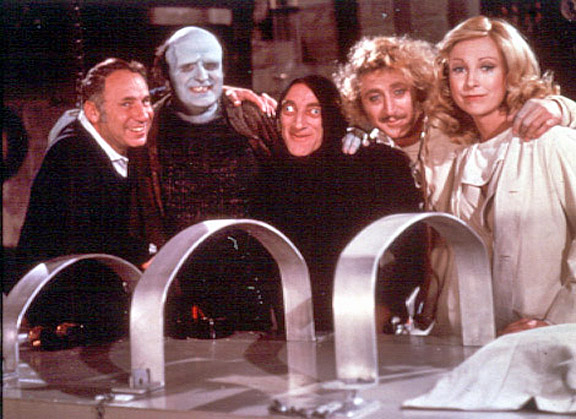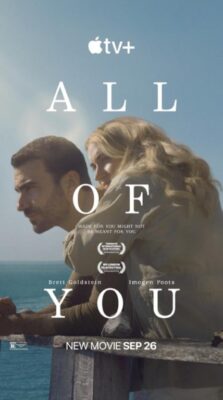“Everybody’s singin’ it, everybody’s hummin’ it, that Tran-syl-VAN-ian Lullaby!” Mel Brooks conducted an imaginary symphony orchestra. “Isn’t it a lovely tune?” he asked. “It was composed just for our movie. I said I needed a little romantic music for the Grandson of Frankenstein’s wedding night, and here’s what I got.”
The, uh, haunting melody drifted out of a portable tape deck and through the big Sound Stage Five on the 20th Century-Fox lot. The stage has been outfitted as the interiors and exteriors (and mad scientist’s laboratory) of Frankenstein’s gothic castle in Transylvania, as seen most memorably in the 1935 production of “Bride of Frankenstein.”
This time the familiar old Transylvanian settings have been invoked for Brooks’ newest comedy, “Young Frankenstein,” which is sort of a cross between “Frankenstein,” “Young Edison” and stark madness. It’s an expensive movie as comedies go — about $2.5 million — but Brooks figures his last comedy, “Blazing Saddles,” will gross about $20 or $30 million and so he can afford it.
“The movie is set in 1974,” Brooks announces, leading a party of technicians up a ladder to a parapet. His star, Gene Wilder, is already up there, looking anxiously at the sky. I wasn’t sure I’d heard him right, and I checked out the ancient Gothic battlements and the scrawny horse nudging in the hay in front of the entranceway.
“That’s right, 1974, and watch the ladder, we got the cut-rate insurance plan,” Brooks said. “It’s set in 1974 in New York City, where young Freddy Frankenstein is disturbed by the bad image that his grandfather, who was THE Frankenstein, is getting in the media.
“So he takes his vacation and flies back to Transylvania to visit the old family spread, which is still standing, by the way. And once he’s here, he gets entranced by all this old scientific equipment his ancestors left lying around, and the next thing you know, the boy’s trying to put together his own monster. ‘Also, he falls in love and marries one of the local maidens.”
By this time we were all on top of the parapet, and Wilder was looking somewhat uneasily over the edge. Wilder isn’t so much a comedian as a gifted actor who makes pathos, chicanery, timidity and roguishness (and about anything else) seem funny. He got his first movie break as the undertaker who was kidnapped in “Bonnie and Clyde,” and he was in “Willy Wonka and the Chocolate Factory” and in two of Brooks’ previous productions, “The Producers” (1968) and “Blazing Saddles.” This time he plays Frankenstein.
“I like to have Gene in my pictures because then I know it’s a Mel Brooks picture and I only like to work on the best pictures,” Brooks explained.
“Tell me how this is going to work,” Wilder said.
“The monster is climbing up the vines on the castle wall,” Brooks explained. “And you’re up here on top, and…” He paused and looked at me. “Hey, that’s right,” he said. “You’re from Chicago. You know who we got playing the monster? Peter Boyle. From Second City. Makes the greatest Frankenstein’s monster you ever saw. Tell that to the folks back home: After an international talent search, Mel Brooks says only a Chicago monster fits the ticket.”
He turned back to Wilder. “You got the picture?”
“What if I fall off?” Wilder said.
“Zip, that’s it,” Brooks said. “We print it and the show ends with young Frankenstein’s death from falling off the parapet.”
“We’ll have a platform out of sight to catch you if you fall,” said a stunt coordinator.
“Do you think it ought to rain?” said Wilder.
“What do we need for rain up here?” said Brooks.
“Well, we could string the pipes and give you rain, but then you got a problem with the run-off,” said a special effects man.
“Your problem with the run-off is, let me guess, no place to run it off,” said Brooks.
“We would have to coordinate the drains. We already have drains in the courtyard…”
“Maybe just some lightning and thunder, as if it’s about to rain.” Wilder suggested.
“That’s it!” Brooks said. “Kid, you’re a genius!”
He slapped him on the back and led the way back down the ladder. At ground level, and behind a few more vast stone walls, we found Frankenstein’s laboratory. A giant chair sat in the center of it, with arm and leg buckles and yards of heavy chain to restrain the monster. Electrical devices and strangelyshaped flasks lined the walls.
“Does this look familiar?” Brooks said. “It should. This doesn’t look like Frankenstein’s original laboratory; it is Frankenstein’s original laboratory. The special effects guy who designed the lab for ‘Bride of Frankenstein’ kept all his props. He set the lab up for us just like it was the first time. Works fine, too. We can turn out a monster an hour during peak production periods.”
It was time for lunch. The commissary at 20th CenturyFox reflects some of the belt-tightening that’s going on all over Hollywood. In the old days, producers, directors and the big stars ate in a special executive dining room with big double doors that faced a giant mural with Darryl F. Zanuck in the middle of it. Many executives whose pictures were running over budget preferred to avoid indigestion by sitting with their eyes away from Zanuck’s penetrating stare. Now Zanuck overlooks a self-service short order line.
Brooks hurried through the line, grabbing a double cheeseburger, potato chips and iced tea. On the way to a table, he passed the company’s president, Gordon Stulberg, dining at a table that would have been for extras in the old days.
“Hey, Gordon!î Brooks said. “You never come over to visit the set! You know where we are? Five? Come over and visit sometime! We only got four more days of shooting. If you were really Jewish, wouldn’t you come over and look at the store?”
Stulberg laughed and said he would visit in the next couple of days.
“You lose the way, call, I’ll send a boy,” Brooks said. He sat down and put ketchup on his cheeseburger.
“Lots of trouble the other day,” he said. “We had to photograph a rat coming down the steps. No luck. It’s bad because rats will not take direction. They just refuse to turn this way, turn that way…Gordon?”
Stulberg, getting up from his table, looked around.
“Now they say ‘Blazing Saddles’ will do $30 million,” Brooks informed him.
“Fantastic, Mel,” said Stulberg.
“It’s a Warner Bros. picture but I tell him that to keep his spirits up,” Brooks said. “I got a three-picture deal here at 20th. And, how would Variety put it? I’m skying Westward to firm up the pact. No, that’s wrong; I’m already here. I’ve got it: I’m skying Eastward, to tell the folks.
“People ask my why I’m doing a monster picture. I say it’s so people will know for once and all the difference between Frankenstein and the monster. When I did ‘Blazing Saddles,’ they said, ‘What? Mel Brooks directing a Western?’ Why not! I’ve seen more Westerns than anybody. We sat through three Westerns every Saturday until our mothers came to find us with a flashlight. I know more about Westerns than any cowboy, and so did all the kids on my block…“
Back on the sound stage, it was time for the first shot of the afternoon. It required Wilder, dressed in a Gothic bathrobe, to kick open the door of the bridal chamber, carry his bride through, and place her on the floor. Then he says, “Welcome home, Mrs. Frankenstein,” and she says, “Frankenstein — that name used to scare me when I was a little girl.”
And then, as he waits impatiently in the bedroom, she slips into the dressing room, from which the strains of her humming the “Transylvanian Lullaby” soon emerge. “That song,” says Wilder, inevitably…”I’ve heard it — somewhere before…
“The entire picture will be in black and white,” Brooks said. “No color. That gives a cartooning effect. And every single thing we do with the camera will be traditional. No zooms, but lots of iris shots, lots of wipes, lots of ending love scenes with a close-up of the logs blazing in the fireplace. This picture will have a modicum of class. And it will differ from ‘Blazing Saddles’ in one essential, which is that it will have a plot.”
And then, as he waits impatiently in the bedroom, she slips into the dressing room, from which the strains of her humming the “Transylvanian Lullaby” soon emerge. “That song,” says Wilder, inevitably…”I’ve heard it — somewhere before…
“The entire picture will be in black and white,” Brooks said. “No color. That gives a cartooning effect. And every single thing we do with the camera will be traditional. No zooms, but lots of iris shots, lots of wipes, lots of ending love scenes with a close-up of the logs blazing in the fireplace. This picture will have a modicum of class. And it will differ from ‘Blazing Saddles’ in one essential, which is that it will have a plot.”
“The entire picture will be in black and white,” Brooks said. “No color. That gives a cartooning effect. And every single thing we do with the camera will be traditional. No zooms, but lots of iris shots, lots of wipes, lots of ending love scenes with a close-up of the logs blazing in the fireplace. This picture will have a modicum of class. And it will differ from ‘Blazing Saddles’ in one essential, which is that it will have a plot.”












